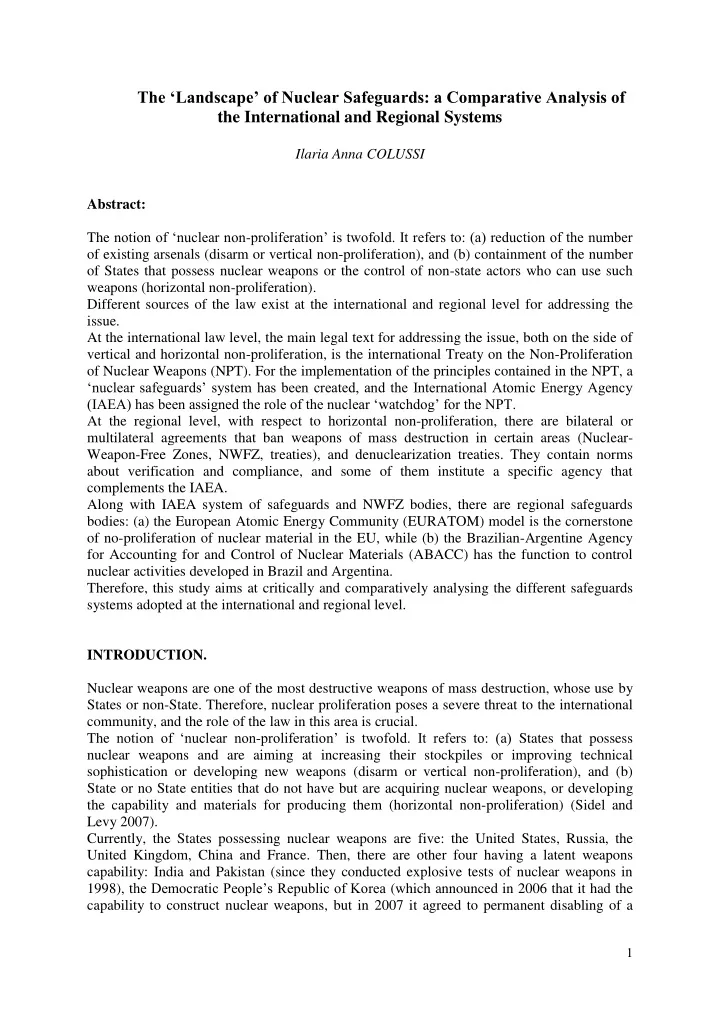

The ‘Landscape’ of Nuclear Safeguards: a Comparative Analysis of the International and Regional Systems Ilaria Anna COLUSSI Abstract: The notion of ‘nuclear non - proliferation’ is twofold. It refers to: (a) reduction of the number of existing arsenals (disarm or vertical non-proliferation), and (b) containment of the number of States that possess nuclear weapons or the control of non-state actors who can use such weapons (horizontal non-proliferation). Different sources of the law exist at the international and regional level for addressing the issue. At the international law level, the main legal text for addressing the issue, both on the side of vertical and horizontal non-proliferation, is the international Treaty on the Non-Proliferation of Nuclear Weapons (NPT). For the implementation of the principles contained in the NPT, a ‘nuclear safeguards’ system has been created, and the International Atomic Energy Agency (IAEA) has been assigned the role of the nuclear ‘watchdog’ for the NPT. At the regional level, with respect to horizontal non-proliferation, there are bilateral or multilateral agreements that ban weapons of mass destruction in certain areas (Nuclear- Weapon-Free Zones, NWFZ, treaties), and denuclearization treaties. They contain norms about verification and compliance, and some of them institute a specific agency that complements the IAEA. Along with IAEA system of safeguards and NWFZ bodies, there are regional safeguards bodies: (a) the European Atomic Energy Community (EURATOM) model is the cornerstone of no-proliferation of nuclear material in the EU, while (b) the Brazilian-Argentine Agency for Accounting for and Control of Nuclear Materials (ABACC) has the function to control nuclear activities developed in Brazil and Argentina. Therefore, this study aims at critically and comparatively analysing the different safeguards systems adopted at the international and regional level. INTRODUCTION. Nuclear weapons are one of the most destructive weapons of mass destruction, whose use by States or non-State. Therefore, nuclear proliferation poses a severe threat to the international community, and the role of the law in this area is crucial. The notion of ‘nuclear non - proliferation’ is twofold. It refers to: (a) States that possess nuclear weapons and are aiming at increasing their stockpiles or improving technical sophistication or developing new weapons (disarm or vertical non-proliferation), and (b) State or no State entities that do not have but are acquiring nuclear weapons, or developing the capability and materials for producing them (horizontal non-proliferation) (Sidel and Levy 2007). Currently, the States possessing nuclear weapons are five: the United States, Russia, the United Kingdom, China and France. Then, there are other four having a latent weapons capability: India and Pakistan (since they conducted explosive tests of nuclear weapons in 1998), t he Democratic People’s Republic of Korea (which announced in 2006 that it had the capability to construct nuclear weapons, but in 2007 it agreed to permanent disabling of a 1
nuclear reactor complex at Yongbyon), and Israel (which is thought to possess arsenals, but has never confirmed nor denied). Other “suspected” States are: Egypt, Libya, Iran, Iraq, Myanmar , and Syria. Considering the sources of the law regulating this issue at the international and regional level, it is possible to observe two main frameworks: INTERNATIONAL LAW REGIONAL LAW HORIZONTAL/VERTICAL Treaty on the Non-Proliferation of - bilateral or multilateral PROLIFERATION Nuclear Weapons (NPT) agreements that ban weapons of mass destruction in certain areas (Nuclear Free Weapons Zones) - Limited Test Ban Treaty - Seabed Treaty - Antarctic Treaty - Outer Space Treaty - Moon Agreement A central issue for the overall international security architecture is to ensure the respect and compliance of these agreements. Indeed, States that adhere to an international treaty or a regional agreement shall respect the fundamental principle of “ pacta sunt servanda ”. At the same time, for the implementation of the principles and obligations embedded in these agreements it is essential to set up a verification and safeguards system. As affirmed by Tariq Rauf, “ verification should detect evidence of any violations. [...] Second, the verification system should deter violations of the treaty. Third, the verification system should help build confidence in the viability of the treaty through conclusions that the States parties are complying with limits and obligations in the treaty ” ( Rauf 2015). Safeguards provisions are established at the international and regional level. Thus, this paper aims at critically and comparatively analysing the different safeguards systems adopted. 1. INTERNATIONAL LAW: THE TREATY ON THE NON-PROLIFERATION OF NUCLEAR WEAPONS (NPT) AND THE IAEA SAFEGUARDS SYSTEM The Treaty on the Non-Proliferation of Nuclear Weapons (NPT), signed in 1968, 1 and entered into force in 1970, is the “cornerstone of the nuclear non proliferation regime” (Persbo 2012, 2). It is the result of a ‘bargain’ among nuclear weapon and non -nuclear weapon States, since non-nuclear weapon States undertake not to build or acquire nuclear weapons, while nuclear weapons States agree to pursue negotiations on nuclear disarmament. Thus, the Treaty aims at preventing the spread of nuclear weapons and weapons technology, and promoting cooperation in the peaceful uses of nuclear energy, thereby seeking to achieve complete nuclear disarmament. For the verification and implementation of the principles contained in the NPT, a ‘nuclear safeguards’ system has been created, and the International Atomic Energy Agency (IAEA) has been assigned the role of the nuclear ‘watchdog’ for the NPT . The IAEA has been established in 1957 to help nations develop nuclear energy for peaceful purposes, and control, after the signing of the NPT, the States’ behavior in honoring their commitments under the treaty. It reports to both the United Nations General Assembly and the Security Council. 1 The Treaty on the Non-Proliferation of Nuclear Weapons (NPT) was opened for signature in 1968, and entered into force in 1970. On 11 May 1995, the Treaty was extended indefinitely. 2
Recommend
More recommend